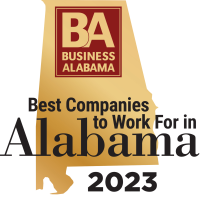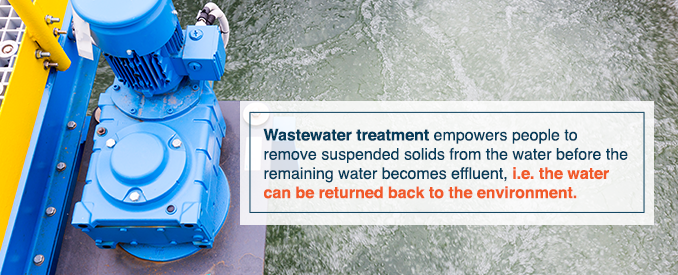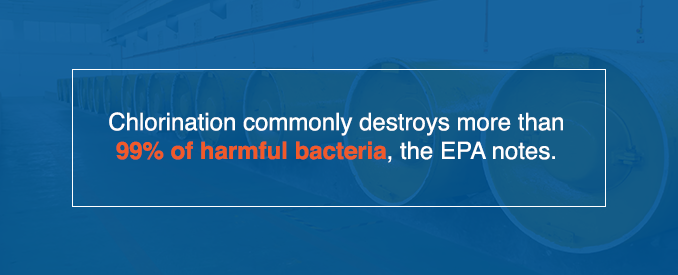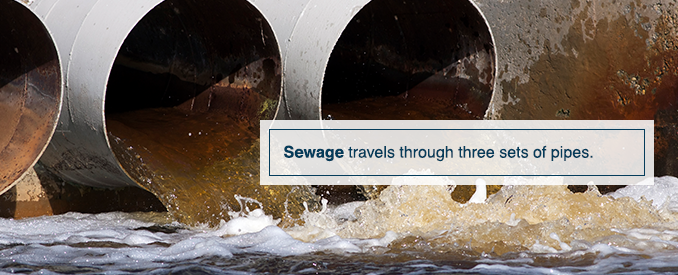
Wastewater treatment plants supply clean water to millions of people worldwide. As such, wastewater treatment plants require state-of-the-art equipment to power their day-to-day operations, including numerous tools that empower these plants to consistently purify water and ensure communities can enjoy the highest-quality water possible.
Did you know that compressed air often plays a key role in wastewater treatment? With efficient compressed air supplying wastewater treatment equipment, operators can be better equipped to manage various wastewater treatment processes reliably and with ease.
Here’s a closer look at wastewater treatment, along with the value of air compressors for wastewater treatment plants.
Contact Us Learn More Find a Dealer Near You
The Importance of Wastewater
UN-Water’s 2014 World Water Development Report (WWDR) indicated that more than 80% of used water worldwide is not collected or treated, making this water a threat to human and environmental health. But with support from wastewater treatment plants, people globally may be able to enjoy the benefits of clean water for years to come.
Wastewater includes potential energy, thermal energy and chemically bound energy, according to UN-Water. As a result, it offers immense value if it is harnessed properly — something that has proven to be a major challenge for many wastewater treatment plants around the world.
There are many reasons to purify wastewater as well, including:
• Health Concerns — Failure to clean water properly may result in health issues due to dangerous bacteria contained within the water.
• Maintenance of Fisheries and Wildlife Habitats — Fish and other wildlife depend on clean water. Without it, these species would not be able to survive in their natural habitats.
• Recreational Areas — Beaches, lakes and other bodies of water may become unsafe areas if water is not treated properly.
Wastewater treatment empowers people to remove suspended solids from the water before the remaining water becomes effluent, i.e. the water can be returned back to the environment. Therefore, wastewater treatment plants — and air compressors that power wastewater treatment equipment— have become exceedingly valuable in global communities.
What Is Wastewater Treatment?
Wastewater treatment is paramount. Without without the right wastewater treatment processes in place, populations may struggle to find clean water for drinking, cleaning and other everyday tasks.
Compressed air in wastewater treatment helps drive wastewater treatment processes that remove or reduce a number of harmful particles, including:
1. Suspended Solids — These particles usually clog rivers or channels.
2. Biodegradable Organics (BOD) — Microorganisms commonly rely on BOD as “food.” They use a combination of BOD and oxygen to survive and multiply.
3. Pathogenic Bacteria — These disease-causing organisms may be problematic in areas where water is used for drinking.
4. Nutrients — Nitrates, phosphates and other nutrients may cause high concentrations of algae.
Furthermore, there are three types of wastewater treatment:
1. Primary — Also referred to as “mechanical” treatment, primary treatment involves the removal of gross, suspended and floating solids from raw sewage. As part of primary treatment, screening is used to capture solid objects and sediment. Meanwhile, chemicals also may be used to speed up the sedimentation process.
Primary treatment frequently delivers significant results, and the World Bank Group (WBG) points out primary treatment can minimize the BOD of incoming wastewater by 20% to 30% and total suspended solid by roughly 50% to 60%.
2. Secondary — Secondary, aka “biological” treatment, eliminates any dissolved organic matter after primary treatment. It leverages microbes that ingest organic matter as food and transform it into carbon dioxide, water and energy. Then, secondary treatment is followed by a “secondary sedimentation” process that involves the removal of additional suspended solids.
In most cases, about 85% of suspended solids and BOD can be removed during secondary treatment, according to WBG.
3. Tertiary — The final step, tertiary treatment, is designed to eliminate almost all of the impurities from sewage to produce near drinking-water quality. Tertiary treatment may be expensive and requires a highly trained staff of plant operators, a consistent energy source and various chemicals and equipment to ensure it is performed properly.
Now, let’s take a closer look at the aforementioned types of wastewater treatment.
Primary Treatment
Primary treatment begins the moment sewage enters a wastewater treatment plant. At this point, sewage will flow through a screen that eliminates debris, sticks and other large objects that could otherwise clog or damage plant equipment. Then, the sewage will move on to a grit chamber that removes sand, stones and other small particles. This chamber serves a pivotal role in communities where sand, gravel and other grainy materials could wash into sewers with storm water, and ensures such materials can be removed correctly at any time.
Following the screening process, sewage will still include both organic and inorganic matter, along with various suspended solids. All of these materials, however, can be removed thanks to a sedimentation tank.
A sedimentation tank ensures that suspended solids sink to the bottom and form a mass, commonly referred to as primary biosolids or sludge. These materials are removed from the tank via pumping. Also, the materials may be further treated by a fertilizer, moved to a landfill or incinerated for proper disposal.
Primary treatment offers substantial value because it serves as the initial step of the treatment cycle. Comparatively, it is not the lone step in this process, and secondary and tertiary treatments play crucial roles in producing top-quality water in communities globally.
Secondary Treatment
The U.S. Environmental Protection Agency (EPA) states that about 85% of organic matter is removed during secondary treatment. At this point, a trickling filter, i.e. a collection of stones that run about three to six feet deep, is used to absorb organic matter. This filter leverages bacteria that gathers and multiplies on the stone, collecting organic matter quickly. After the trickling filter retrieves organic matter, cleaner water will move through a series of pipes for additional treatment.
Partially treated sewage then will move into a sedimentation tank to remove excess bacteria. An activated sludge process will also be used to eliminate the bacteria by bringing the bacteria into close contact with air and sludge.
After the sewage leaves the sedimentation tank, it is pushed into an aeration tank. Here, the sewage is mixed with air and sludge and will remain in place for at least a few hours. The bacteria will break down the organic matter that is harmless.
Next, the sewage will move into another sedimentation tank where bacteria will be eliminated entirely. The secondary treatment often concludes with effluent from this tank being disinfected with chlorine before it is discharged.
The EPA notes that chlorination commonly destroys more than 99% of harmful bacteria, and in many municipalities, a chlorine solution is manufactured on-site to avoid transporting and storing large amounts of chlorine at a given time, further protecting people.
Tertiary
Tertiary treatment represents the final stage of the water treatment cycle. It involves the removal of inorganic compounds such as nitrogen and phosphorous, along with bacteria, parasites and viruses.
As part of tertiary treatment, wastewater will move from a biological reactor to a pumping station. This wastewater then will move into a flash mixer that can be used to eliminate harmful particles and any remaining solids.
After the wastewater is purified in the flash mixer, the wastewater is fed through sand filters. Tiny particles are clustered together and trapped by the sand, while clear water moves into a chlorine contact tank. Sand filters are backwashed daily to remove tiny particles, and the backwash water goes through each stage of the wastewater treatment cycle, starting with primary treatment.
Lastly, a chlorine contact tank helps purify tertiary treated wastewater. Chlorine is used to eliminate microorganisms such as bacteria, parasites and viruses. Then, chlorinated water moves to the discharge tank, and any remaining chlorine is removed by incorporating sodium bisulphite before the water is discharged.
How Does Sewage Travel to a Wastewater Treatment Plant?
Sewage travels through three sets of pipes. First, water will travel from pipes in a home or business into local sewers that are managed by city and town sewer departments. Wastewater then will travel to interceptor sewers that usually range from eight inches to 11 feet in diameter. Finally, the wastewater will reach a wastewater treatment plant.
In addition, sewage comes from myriad sources, including kitchens and bathrooms in residential and commercial buildings. Thousands of homeowners and business operators may contribute to sewage that is provided to a wastewater treatment plant. Also, rainy weather, street runoff and even cracks often allow groundwater to enter the sewage system.
A wastewater treatment plant will clean the liquid part of sewage and try to eliminate toxic metals, excess nutrients and pathogens from wastewater. Upon successful completion of the wastewater treatment cycle, the resulting liquid will be discharged into bays, rivers, lakes and streams as effluent. Conversely, leftover solids and semi-solids that are removed from wastewater make up biosolids.
Common Wastewater Treatment Processes
Many wastewater treatment processes are used day after day, and some of the most common wastewater treatment processes include:
1. Activated Sludge Process
This process involves the separation of suspended solids from wastewater via sedimentation. It is commonly used in medium- and large-scale wastewater treatment plants and begins when effluent enters the aeration tank or lane.
Next, low-pressure air is added via a grid of diffusers, and water will start to pass through the process over the course of several hours. During this time, sludge retention may vary. In cold temperatures, these rates could last up to several weeks.
2. Lagoon Aeration
Like the activated sludge process, lagoon aeration is performed in many large- and mid-sized wastewater treatment plants. Lagoon aeration involves several shallow lagoons that act as aeration basins and holding tanks. These lagoons feature surface aerators and diffuser systems.
3. Membrane Bioreactor (MBR)
The MBR process is a variation of the activated sludge process and utilizes additional filtration to deliver a higher-quality effluent. It requires an ultrafine membrane filter with pumps installed on it to create a vacuum that pulls the effluent through the membrane, and ultrafine holes in the membrane keep microbes in the aeration basis.
However, it is important to note that the membrane may become clogged at times, which means it needs to be cleaned for optimal results.
4. Moving Bed Biofilm Reactor (MBBR)
Designed for scalability, the MBBR process represents a great choice for wastewater treatment plants of all sizes. It requires a reactor that is filled with thousands of biofilm carriers that safeguard bacteria that is used to minimize pollutants in wastewater. Moreover, a diffuser grid administers air that moves the biofilm carriers across the basis to provide ample aeration for biofilm growth.
5. Sequencing Batch Reactor (SBR)
SBR is a compact process that is frequently used at small- and mid-sized wastewater treatment plants. This process involves the use of two tanks that alternate between multiple treatment stages. To begin the process, one tank will be filled. After this happens, wastewater will move to the second tank, and the process will restart. As such, SBR ensures a wastewater treatment plant is equipped to accommodate higher loads.
6. Anaerobic Digestion
With anaerobic digestion, a wastewater treatment plant will be able to treat sludge that develops during the wastewater treatment process. Anaerobic digestion involves a series of microorganisms that transform solid waste into carbon dioxide, methane and other gases. Then, biogas is taken from a reactor and treated before it is injected into a generator or flared to minimize greenhouse gas emissions.
Of course, without an air compressor, some of these water treatment processes may be impossible to perform.
How Does Compressed Air Support Wastewater Treatment?
There are many applications for air compressors in wastewater treatment, including:
1. Back Washing Sand Filtration
Compressed air can be used to expand a filter bed and break up compacted material with ease. Also, clean backwash water can be pumped in, while loose material becomes suspended and suspended particles are pushed through the filter and carried away.
2. Desalination
Desalination refers to the process of removing dissolved salts from water and enables a wastewater treatment plant to produce fresh water from seawater or brackish water quickly and efficiently. An air compressor can help with desalination, ensuring a wastewater treatment plant can remove salt and produce potable water for domestic or municipal use.
3. Wastewater Disposal
Air compressors may be used to power central vacuum systems that drive the disposal of wastewater. That way, wastewater can be collected, drained and eliminated at the same time.
4. Digestion Tank Cleaning and Maintenance
Digestion tanks serve crucial roles in wastewater treatment plants, as these tanks are activated via compressed air that mixes sludge with oxygen to boost gas yield and retention time. Plus, warm compressed air frequently delivers the required results.
5. Slurry Liquid Pumping
From tough abrasives to viscous liquids found in wastewater treatment plants, slurry liquid can be troublesome. Fortunately, slurry liquid pumps can be powered by air compressors and ensure slurry can remain in suspension and travel from one tank to another with ease.
6. Suction Pressure
Air compressors can be used to provide the necessary suction pressure for effective removal of wastewater and cleaning of sewer networks. With air compressors, wastewater contaminants can be removed and flushed out periodically via pumps.
7. Wastewater Purification
Activated sludge tanks are becoming more common in wastewater treatment plants because these tanks are designed to be cost-effective and space-efficient. Meanwhile, air compressors supply the pressure needed to maximize the oxygen yield to purify wastewater properly.
Clearly, an air compressor is necessary for a wastewater treatment plant, On the other hand, and finding the right one can be exceedingly challenging for new operators at wastewater treatment plants.
How to Choose an Air Compressor
For wastewater treatment plants, it is essential to find an air compressor that delivers:
• Reliability — An air compressor should be engineered to last using top-notch components, ensuring the compressor can operate for extended periods of time.
• Low Lifecycle Costs — A wastewater treatment plant operation should considered the total cost of ownership, including maintenance and repair costs to keep any air compressor running. Select an air compressor that offers an easy-too-maintain lifecycle.
• Energy Efficiency — An air compressor likely will be used every day in a wastewater treatment plant, and a well-designed compressor will offer operating efficiencies that save energy lowering overall costs to operate while maintaining performance.
• Easy to Install — An air compressor should be simple to install and be ready to deploy when commissioned and small footprints and maneuverability should be considered.
• Low-Noise Operation — With the right air compressor, workers can rest assured that they’re not exposed to hazardous sound levels. Selecta model that won’t be a distraction.
Luckily, a wide range of air compressors are available to ensure compressed air can be used to keep solids in suspension and supply oxygen support to processing bacteria throughout the wastewater treatment cycle.
Some of the most common air compressors for wastewater treatment include:
1. Reciprocating — A reciprocating air compressor features a positive displacement compressor that leverages a crankshaft-driven piston and cylinder. Typically, a single-stage reciprocating piston compressor will move air into the cylinder where it is compressed in a single piston stroke of approximately 120 PSI.
Then, the air is pushed to a storage tank. There also is a two-stage compressor option, which uses an extra step to compress the air by utilizing a second, smaller piston to a pressure of up to 175 PSI.
2. Rotary Screw — With a rotary screw air compressor, there is a positive displacement compression system that utilizes two identical helical screws. An oil-flooded rotary screw compressor employs a lubricant that bridges the gap between the rotors to deliver an air-tight hydraulic seal. Then, the compressor transfers mechanical energy between the two rotors, air rotates through the threads as the screws turn and the meshing screws push the air through the compressor for consistent results.
3. Oil-Free — If a wastewater treatment plant requires 100% oil-free air, consider an oil-free compressor. This type of compressor prevents contamination in even the smallest quantities, helping a wastewater treatment plant minimize production downtime and contamination risks. An oil-free compressor is also designed for maximum efficiency and air quality.
To properly evaluate all air compressor options for a wastewater treatment plant, it’s necessary to consider the amount of pressure that each type of compressor can provide.
The overall efficiency of the equipment should also be considered, especially where reducing electrical consumption is important.
Select Quincy Compressor for Wastewater Treatment Support
Let’s face it: finding the right air compressor for a sewage treatment plant or wastewater treatment plant can be difficult, especially if you’re looking to purchase compressed air equipment for the first time. But with Quincy Compressor, you can choose from a number of suitable options.
At Quincy, we understand that purchasing an air compressor for wastewater treatment is a major decision. As such, our expert dealers will work with you to help take the guesswork out of finding the perfect air compressor for your wastewater treatment plant.
We supply a variety of efficient and reliable options that are sure to fulfill your air compressor needs. Plus, we’ve established a reputation for providing engineered solutions that deliver uncompromising reliability for demanding applications, ensuring that the solution you install will operate reliably and our network of service providers can keep It operating at peak performance to keep the effluent water flowing.
Ready to explore our offerings of air compressors for wastewater treatment? To find your nearest dealer, please visit our Sales and Service Locator.










